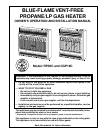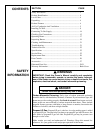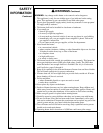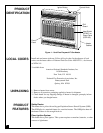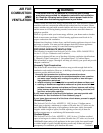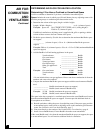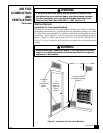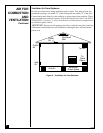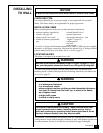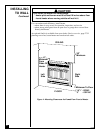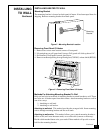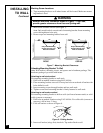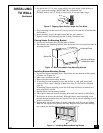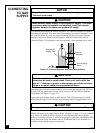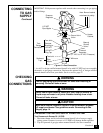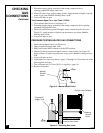
5
101805
AIR FOR
COMBUSTION
AND
VENTILATION
WARNING ICON G 001
WARNING
This heater shall not be installed in a confined space unless
provisions are provided for adequate combustion and ventilation
air. Read the following instructions to insure proper fresh air for
this and other fuel-burning appliances in your home.
Today’s homes are built more energy efficient than ever. New materials, increased
insulation, and new construction methods help reduce heat loss in homes. Home
owners weather strip and caulk around windows and doors to keep the cold air out
and the warm air in. During heating months, home owners want their homes as
airtight as possible.
While it is good to make your home energy efficient, your home needs to breathe.
Fresh air must enter your home. All fuel-burning appliances need fresh air for
proper combustion and ventilation.
Exhaust fans, fireplaces, clothes dryers, and fuel burning appliances draw air from
the house to operate. You must provide adequate fresh air for these appliances.
This will insure proper venting of vented fuel-burning appliances.
Continued
Unconfined Space
The National Fuel Gas Code, ANSIZ223.1, 1992, Section 5.3 defines uncon-
fined space as having a minimum air volume of 50 cubic feet (127 cubic cm) for
each 1000 Btu/Hr input rating of all appliances in the space (cubic feet equals
length x width x height of space). Include adjoining rooms only if there are
doorless passageways or ventilation grills between the rooms.
Confined Space
The National Fuel Gas Code, ANSIZ223.1, 1992, Section 5.3 defines confined
space as having an air volume of less than 50 cubic feet (127 cubic cm) for each
1000 Btu/Hr input rating of all appliances in the space (cubic feet equals length
x width x height of space). Include adjoining rooms only if there are doorless
passageways or ventilation grills between the rooms.
PROVIDING ADEQUATE VENTILATION
The following is excerpts from National Fuel Gas Code. NFPA 54/ANSI Z223.1,
Section 5.3, Air for Combustion and Ventilation.
All spaces in homes fall into one of the three following ventilation classifications:
1. Unusually Tight Construction; 2. Unconfined Space; 3. Confined Space.
The information on pages 5 through 8 will help you classify your space and provide
adequate ventilation.
Unusually Tight Construction
The air that leaks around doors and windows may provide enough fresh air for
combustion and ventilation. However, in buildings of unusually tight construction,
you must provide additional fresh air.
Unusually tight construction is defined as construction where:
a. walls and ceilings exposed to the outside atmosphere have a continu-
ous water vapor retarder with a rating of one perm or less with open-
ings gasketed or sealed
and
b. weather stripping has been added on openable windows and doors
and
c. caulking or sealants are applied to areas such as joints around window
and door frames, between sole plates and floors, between wall-ceiling
joints, between wall panels, at penetrations for plumbing, electrical, and
gas lines, and at other openings.
If your home meets all of the three criteria above, you must provide addi-
tional fresh air. See
Ventilation Air From Outdoors
, page 8
.
If your home does not meet all of the three criteria above, proceed to page 6.



